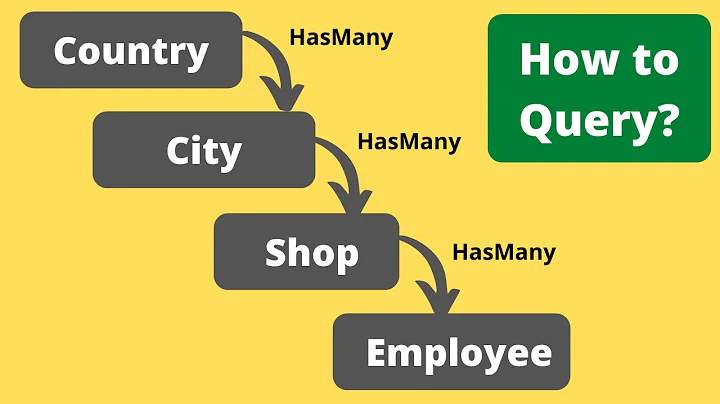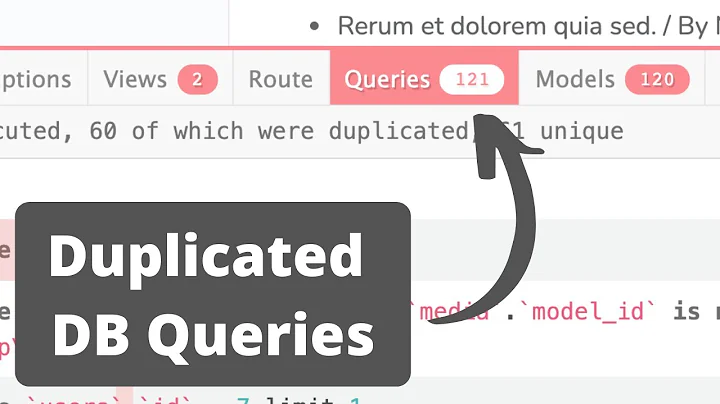Laravel Eloquent - Attach vs Sync
Solution 1
attach():
- Insert related models when working with many-to-many relations
- No array parameter is expected
Example:
$user = User::find(1);
$user->roles()->attach(1);
sync():
Similar to the attach() method, the sync() method is used to attach related models. However, the main differences are:
sync()accepts an array of IDs to place on the pivot table- Secondly, most important, the sync method will delete the data from the pivot table if the model does not exist in the array, and insert only the new items to the pivot table.
Example:
user_role
id user_id role_id 1 12 1 2 12 5 3 12 2
$user = User::find(12);
$user->roles()->sync(array(1, 2, 3));
The above operation will delete:
id user_id role_id 2 12 5
And insert role_id 3 to the table.
user_role table
id user_id role_id 1 12 1 3 12 2 4 12 3
Solution 2
To make it even simpler:
The attach function only adds records to the Pivot table.
The sync function replaces the current records with the new records. This is very useful for updating a model.
Example:
Assuming you have a created Post that has many Tags attached on it where the Tags ID's are [1,2,3].
And the user has the ability to update the Post and its Tags.
The user will send you the new Tags ID's [3,4,5].
If you use the sync function, the new Tags of the Post will be [3,4,5] only.
If you use the attach function, the new Tags of the Post will be [1,2,3,4,5].
Solution 3
Posted answers don't mention syncWithoutDetaching, so here is my simple take.
If you want to:
- add the model to the relation, allowing for duplicates, use
attach() - add the models to the relation, ignoring duplicates, use
syncWithoutDetaching() - set the relation to the exact models, use
sync()
Example:
Calling:
$user->articles()->attach(1);
$user->articles()->attach(2);
$user->articles()->attach(1);
echo $user->articles;
Will return articles: 1, 2, 1
Calling:
$user->articles()->syncWithoutDetaching([1]);
$user->articles()->syncWithoutDetaching([2]);
$user->articles()->syncWithoutDetaching([1]);
echo $user->articles;
Will return articles: 1, 2
Calling:
$user->articles()->sync([1]);
$user->articles()->sync([2, 3]);
$user->articles()->sync([3, 4]);
echo $user->articles;
Will return articles: 3, 4
Related videos on Youtube
Kousha
Biomedical Engineering Master student at UBC. I develop apps for both fun and large scale application for clients.
Updated on May 02, 2022Comments
-
 Kousha about 2 years
Kousha about 2 yearsWhat is the difference between
attach()andsync()in Laravel 4's Eloquent ORM? I've tried to look around but couldn't find anything! -
 Kousha almost 10 yearsThank you! So in theory, using
Kousha almost 10 yearsThank you! So in theory, using$user()->roles()->detach($oldIDs)followed by$user()->roles()->attach($newIDs)is the same as$user()->roles()->sync($newIDs), right? -
 Musa Haidari over 9 yearsAlso there is one second argument for sync() that is by default true, if you pass false, then the non matching will not be deleted. Refer: laravel.com/api/4.2/Illuminate/Database/Eloquent/Relations/…
Musa Haidari over 9 yearsAlso there is one second argument for sync() that is by default true, if you pass false, then the non matching will not be deleted. Refer: laravel.com/api/4.2/Illuminate/Database/Eloquent/Relations/… -
Deenadhayalan Manoharan about 9 yearsget last insert id in sync?
-
 Seiji Manoan almost 9 years@Deena actually pivot tables don't need any ID - so you don't get any ID back :) but you can get the related ones by reusing the model object variable
Seiji Manoan almost 9 years@Deena actually pivot tables don't need any ID - so you don't get any ID back :) but you can get the related ones by reusing the model object variable -
 Henry Bui over 6 yearsHow about when pivot table does not only have 2 columns(user_id, role_id). I want add 1 column is value to pivot table, how can I add data to that column
Henry Bui over 6 yearsHow about when pivot table does not only have 2 columns(user_id, role_id). I want add 1 column is value to pivot table, how can I add data to that column -
 CGriffin over 6 yearsI'm not sure when it was introduced, but there now exists a
CGriffin over 6 yearsI'm not sure when it was introduced, but there now exists asyncWithoutDetaching()method - is the only difference betweenattach()andsyncWithoutDetaching()that the latter can accept an array of IDs? -
 jave.web almost 5 years@CGriffin I find it interesting that
jave.web almost 5 years@CGriffin I find it interesting thatattach/detachmethods have also$touchparameter (not really documented well, but may update timestamps?) - bothsyncandattachtouch based onprotected $touches = [];, but in case ofattachyou can manually turn it off ...For basic operations there should be no difference though.... -
saber tabatabaee yazdi almost 4 yearsmy problem is similar to this . i can use your answer to solve it thanks. stackoverflow.com/a/36573783/308578
-
Maik Lowrey over 3 yearsSmall Note: The attach() method accept arrays of IDs or single value as input. The same goes for the detach() method.






